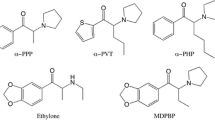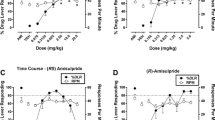Abstract
Rats were trained to performed an aversely motivated discriminative task in a shuttle-box. The administration of phencyclidine (PCP), 2 mg kg−1 SC at −20 min, produced disruption of discriminative performance and an increase in intertrial crosses. There were no changes in avoidance performance or in avoidance latency. Pretreatment with haloperidol, 0.1 or 0.2 mg kg−1 SC at −40 min, or remoxipride 8 mg kg−1 IP at −30 min, did not antagonize the PCP-induced disruption of discriminative performance, nor was the PCP-induced increase in number of intertrial crosses antagonized. In fact, there appeared to be a further increase in intertrial crosses, above PCP levels, by haloperidol treatment and this effect was statistically significant after remoxipride treatment. The present results, together with previous observations that alsod-amphetamine disrupts discriminative conditioned avoidance behavior, suggest the possibility that this model could be used in the search for new, non-dopaminergic, antipsychotic drugs.
Similar content being viewed by others
References
Ahlenius S (1974) Effects of low and high doses ofl- dopa on the tetrabenazine or alfa-methyltyrosine-induced suppression of behavior in a successive discrimination task. Psychopharmacologia 39:199–212
Ahlenius S, Engel J (1975) Antagonism by haloperidol of thel-dopa-induced disruption of a successive discrimination in the rat. J Neural Transm 36:43–49
Ahlenius S, Engel J (1976) Normaliation by antipsychotic drugs of biochemically induced abnormal behavior in rats. Psychopharmacology 49:63–68
Ahlenius S, Carlsson A, Engel J (1975) Antagonism by baclophen of thed-amphetamine-induced disruption of a successive discrimination in the rat. J Neural Transm 36:327–333
Allen RM, Young SJ (1978) Phencyclidine-induced psychosis. Am J Psychiatry 135:1081–1084
Anden N-E, Butcher SG, Corrodi H, Fuxe K, Ungerstedt U (1970) Receptor activity and turnover of dopamine and noradrenaline after neuroleptics. Eur J Pharmacol 11:303–314
Ary TE, Komiskey HL (1982) Phencyclidine-induced release of [3H]-dopamine from chopped striatal tissue. Neuropharmacology 21:639–645
Bowers MB, Jr (1987) The role of drugs in the production of schizophreniform psychoses and related disorders. In: Meltzer HY (ed) Psychopharmacology: The third generation in progress. Raven Press, New York, pp 819–823
Carlsson A (1970) Amphetamine and brain catecholamines. In: Costa E, Garattini S (eds) Amphetamines and related compounds. Raven Press, New York, pp 289–300
Carlsson A (1988) The current status of the dopamine hypothesis of schizophrenia. Neuropsychopharmacology 1:179–186
Carlsson M, Carlsson A (1989) The NMDA antagonist MK-801 causes marked locomotor stimulation in monoamine-depleted mice. J Neural Transm 75:221–226
Freed WJ, Bing LA, Wyatt RJ (1984) Effects of neuroleptics on phencyclidine (PCP)-induced locomotor stimulation in mice. Neuropharmacology 23:175–181
Grover D, Yeragani VK, Keshavan MS (1986) Improvement of phencyclidine-associated psychosis with ECT. J Clin Psychiatry 47:477–478
Johnson KM, Jr (1987) Neurochemistry and neurophysiology of phencyclidine In: Meltzer HY (ed) Psychopharmacology: the third generation of progress. Raven Press, New York, pp 1581–1588
Magnusson O, Fowler CJ, Köhler C, Ögren S-O (1986) Dopamine D2 receptors and dopamine metabolism: relationship between biochemical and behavioral effects of substituted benzamide drugs. Neuropharmacology 25:187–197
Monaghan DT, Bridges RJ, Cotman CW (1989) The excitatory amino acid receptors: their classes, pharmacology, and distinct properties in the function of the central nervous system. Annu Rev Pharmacol Toxicol 29:365–402
Murray TF, Horita A (1979) Phencyclidine-induced stereotyped behavior in rats: dose response effects and antagonism by neuroleptics. Life Sci 24:2217–2226
Randrup A, Munkvad I (1970) Biochemical, anatomical and psychological investigations of stereotyped behavior induced by amphetamines. In: Costa E, Garattini S (eds) Amphetamines and related compounds. Raven Press, New York, pp 695–713
Schlemmer RF, Jr, Jackson JA, Preston KL, Bederka JP, Jr, Garver DL, Davis JM (1978) Phencyclidine-induced stereotyped behavior in monkeys: antagonism by pimozide. Eur J Pharmacol 52:379–384
Siegel S (1956) Non-parametric statistic for the behavioral sciences. McGraw-Hill, New York Toronto London
Sturgeon RD, Fessler RG, Meltzer HY (1979) Behavioral rating scales for assessing phencyclidine-induced locomotor activity, stereotyped behavior and ataxia in rats. Eur J Pharmacol 59:169–179
Sturgeon RD, Fessler RG, London SF, Meltzer HY (1981) A comparison of the effects of neuroleptics on phencyclidine-induced behavior in rat. Eur J Pharmacol 76:37–53
Sutherland NS, Mackintosh NJ (1971) Mechanisms of animal discrimination learning. Academic Press, New York London, pp 24–48
Tyler CB, Miczek KA (1982) Effects of phencyclidine on aggressive behavior in mice. Pharmacol Biochem Behav 17:503–510
Vickroy TW, Johnson KM (1982) Similar dopamine-releasing effects of phencyclidine and nonamphetamine stimulants in striatal slices. J Pharmacol Exp Ther 223:669–674
Wong EHF, Kemp JA, Priestley T, Knight AR, Woodruff GN, Iversen LL (1986) The anticonvulsant MK-801 is a potent N-methyl-d-aspartate antagonist. Proc Natl Acad Sci 83:7104–7108
Author information
Authors and Affiliations
Rights and permissions
About this article
Cite this article
Ericson, E., Ahlenius, S. Phencyclidine-induced disruption of an aversely motivated two-choice successive discrimination in the rat. Psychopharmacology 102, 171–174 (1990). https://doi.org/10.1007/BF02245918
Received:
Revised:
Issue Date:
DOI: https://doi.org/10.1007/BF02245918




